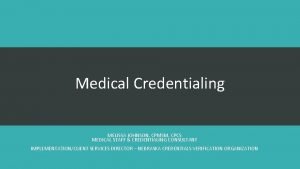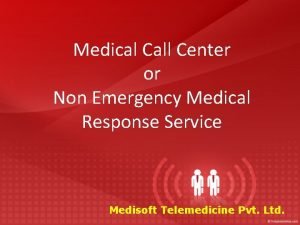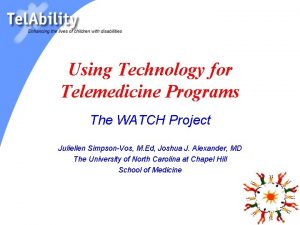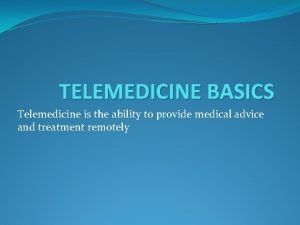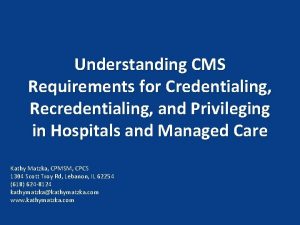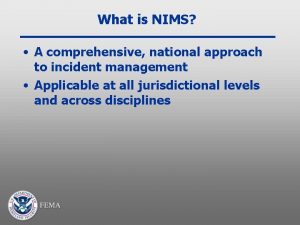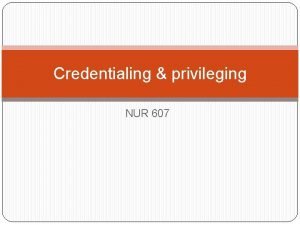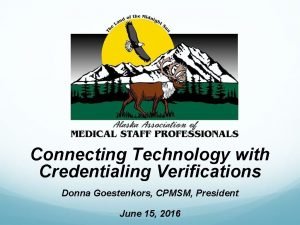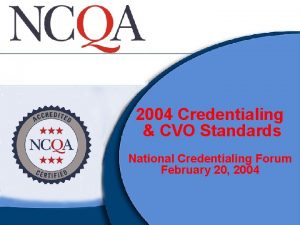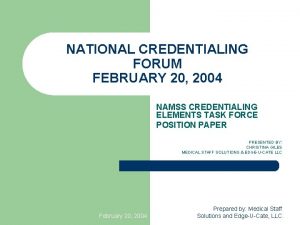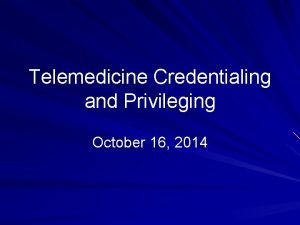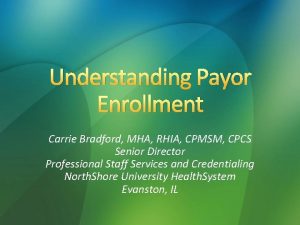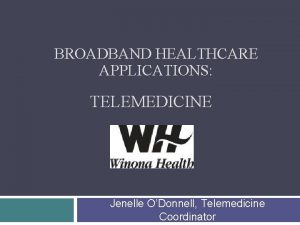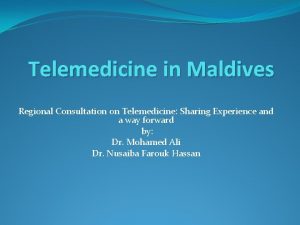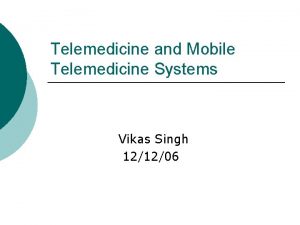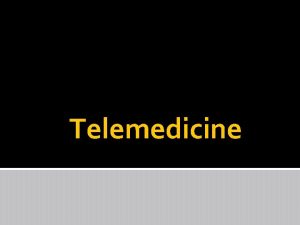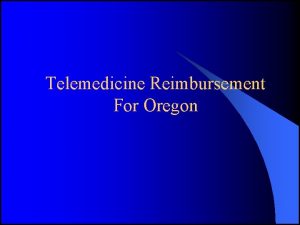Understanding Credentialing Options for Telemedicine Kathy Matzka CPMSM







































- Slides: 39

Understanding Credentialing Options for Telemedicine Kathy Matzka, CPMSM, CPCS www. kathymatzka. com 1

What is Telemedicine? “the provision of clinical services to patients by physicians and practitioners from a distance via electronic communications” Source: CMS Interpretative Guidelines 2

Telemedicine �Non-simultaneous: involve after-thefact interpretation or assessment, such as teleradiology services �Simultaneous: involve “real-time” interpretation or assessment, such as E-ICU services, psychiatry, dermatology 3

Examples of Telemedicine �Videoconferencing �Transmission of still images �Remote monitoring of vital signs �Tele____ [Fill in the blank] 4

What we imagine. . . 5

Reality? 6

Where we think they are. . . 7

Reality? ? ? 8

Trends driving the growth of telemedicine in the US �A growing population, expected to reach more than 360 million by 2030, which will increase the demand for medical services �A projected physician shortage, which could reach 130, 000 by the year 2025 �A rapid increase of older Americans, coping with chronic diseases, many of whom are likely to be home-bound and physically challenged late in life Source: “Balancing Access, Safety and Quality in a New Era of Telemedicine” FSMB, 2011 9

Trends driving the growth of telemedicine in the US �A lack of access to medical services in many parts of the country, especially in rural areas �An explosion in computer-based technology and electronic communications capabilities, particularly in mobile devices �A consumer population that is increasingly at ease with computer-based and electronically enabled transactions in day-to-day life Source: “Balancing Access, Safety and Quality in a New Era of Telemedicine” FSMB, 2011 10

Terminology ) ) ) Distant Site Hospital )) ) ) ) ) Originating Site Distant site telemedicine entity 11

CMS – Telemedicine Privileging Choices Fully Privilege via credential & contract with telemedicine privilege per Medicareentity MS bylaws approvedand CMS Hospital regs 12

Acute Care Hospitals 13

Distant Site TE Definition �Provides telemedicine services �Is not a Medicare-participating hospital �Provides contracted services in a manner that enables a hospital using its services to meet all applicable Co. Ps, particularly those requirements related to the credentialing and privileging of practitioners providing telemedicine services to the patients of a hospital. �Includes a distant-site hospital that does not participate in the Medicare program 14

§ 482. 12(a)(8) - Distant-site Hospital �The GB of the hospital whose patients are receiving the telemedicine services may grant privileges based on its medical staff recommendations that rely on information provided by the distant-site hospital 15

§ 482. 22(a)(3) – Written Agreement Provisions - Hospital �Distant-site hospital is Medicare-participating �The individual distant-site physician or practitioner is privileged at the distant-site hospital which provides a current privilege list �The individual distant-site physician or practitioner has state license �Originating site hospital performs internal review of the distant-site practitioner’s performance and sends the distant-site hospital information for use in the periodic appraisal. At a minimum - adverse events and complaints. 16

Surveyor Notes…. Ask to see…Written agreement and the list provided by the distant-site hospital of the telemedicine physicians and practitioners, including their current privileges and pertinent licensure information. 17

§ 482. 12(a)(9) – Distant-site TE The GB of originating hospital may grant privileges to physicians and practitioners employed by the distantsite TE based on MS recommendations; such MS recommendations may rely on information provided by the distantsite TE 18

§ 482. 22(a)(4)Written Agreement Provisions – TE �TE’s utilization of a medical staff credentialing and privileging process that meets the requirements of the hospital Co. Ps �TE provides a list of all physicians and practitioners covered by the agreement, including their privileges at the distant-site telemedicine entity �The list may not include any physician or practitioner who does not hold privileges at the distant-site telemedicine entity. �The list must be current, so the agreement must address how the distant-site telemedicine entity will keep the list current 19

§ 482. 22(a)(4)Written Agreement Provisions – TE – cont… �Each physician or practitioner who provides telemedicine services to the hospital’s patients under the agreement holds a license issued or recognized by the State where the hospital is located �The hospital has evidence that it reviews the telemedicine services provided to its patients and provides a written copy of this review to the distant-site telemedicine entity for the latter’s use in its periodic appraisal of the physicians and practitioners providing telemedicine services under the agreement. At a minimum, adverse events and complaints. 20

Surveyor Notes…. �Ask the hospital how it verifies that the telemedicine entity employs a credentialing and privileging process that meets or exceeds what is required for hospitals under the Medicare Co. Ps �Surveyors do not attempt to independently verify whether or not the distant-site telemedicine entity’s credentialing and privileging process fulfills the regulatory requirements. �Focus only on whether the hospital takes steps to ensure that the distant-site telemedicine entity complies with the terms of the written agreement. 21

Survey Procedures § 482. 22(c)(6) – MS Bylaws �In the case of telemedicine physicians and practitioners providing telemedicine services under an agreement with the hospital where the hospital’s GB has opted to have the medical staff rely upon the credentialing and privileging decisions of the distant-site hospital or telemedicine entity, verify that the bylaws include a provision permitting such reliance. 22

Inter. Guidelines § 482. 26(c)(1) When telemedicine is used, and the radiologist who interprets radiological tests and the patient are located in different states, the radiologist interpreting the radiological test must be licensed and/or meet the other applicable standards that are required by State or local laws in both the state where the practitioner is located and the state where the patient is located. 23

Critical Access Hospitals 24

§ 485. 616(c) Agreements include �When telemedicine services are furnished to the CAH’s patients through an agreement with a distant-site hospital, the CAH’s governing body or responsible individual may choose to rely upon the credentialing and privileging decisions made by the governing body of the distant-site hospital regarding individual distant-site physicians or practitioners. 25

§ 485. 616(c) Agreements include � Determine, in accordance with State law, which categories of practitioners are eligible candidates for appointment to the medical staff � Appoint members of the medical staff after considering the recommendations of the existing members of the medical staff � Assure that the medical staff has bylaws � Approve medical staff bylaws and other medical staff rules and regulations � Ensure that the medical staff is accountable to the governing body for the quality of care provided to patients � Ensure the criteria for selection are individual character, competence, training, experience, and judgment � Ensure that under no circumstances is the accordance of staff membership or professional privileges in the hospital dependent solely upon certification, fellowship or membership in a specialty body or society 26

§ 485. 616(c) Agreements include �Distant-site hospital is Medicare-participating �The individual distant-site physician or practitioner is privileged at the distant-site hospital which provides a current privilege list �The individual distant-site physician or practitioner has state license �Originating site hospital performs internal review of the distant-site practitioner’s performance and sends the distant-site hospital information for use in the periodic appraisal. At a minimum - adverse events and complaints. 27

§ 485. 641(b)(4) Quality Assurance �The quality and appropriateness of the diagnosis and treatment furnished by doctors of medicine or osteopathy at the CAH are evaluated by-�(i) One hospital that is a member of the network, when applicable; �(ii) One QIO or equivalent entity; �(iii) One other appropriate and qualified entity identified in the State rural health care plan; �Applies to agreements with distant-site telemedicine entity �Agreements with distant- site hospitals give that hospital responsibility 28

Joint Commission Nuances and Differences 29

TJC – Telemedicine Privileging Choices Use cred/priv Fully Privilege decision from credential & using the distant privilege per credentialing site TJC MS info from TJC accredited standards -accredited hosp or amb distant site care org. to make a final decision 30

Using the credentialing and privileging decision of the distant-site - LD. 04. 03. 09 Deemed status only �Distant site GB responsible for process consistent with the cred/priv requirements in the MS chapter �Originating site MS relies on information provided by the distant site and makes recommendation to GB �Originating site GB grants privileges to a distant-site LIP based on originating site recommendation 31

TJC – Originating site may use the decision from the distant site if: �The distant site is TJC accredited hospital/ACO (verify that they follow TJC credentialing standards) �The practitioner is privileged at the distant site for those services to be provided at the originating site �The distant site provides the originating site with a current privilege list (deeming only and CAH) �The originating site has evidence of an internal review of the practitioner’s performance of these privileges and sends to the distant site including complaints and adverse outcomes related to sentinel events resulting from telemedicine �Distant-site practitioner licensed in originating site’s state 32

TJC – CAH only �Distant-site Medicare-participating hospital evaluates care provided in CAH �If distant site TE, care is evaluated by hospital that is part of network, QIO or equivalent entity, or entity identified in state rural health plan 33

TJC – LD. 04. 03. 09 �MS clinical leaders and MS provided opportunity to advise about sources of clinical services that will be provided through a contractual arrangement and designated leaders must approve these agreements �Services must be monitored by establishing performance expectations �The leaders who monitor the contracted services are the GB (deemed status) 34

TJC – Non-Deemed �If the hospital establishes a contract with another accredited organization for services that will be provided off-site, it can do one of two things: �Verify that all LIPs who will be providing patient care, treatment, and services have appropriate privileges (obtain a copy of the provider’s privilege form or list of approved privileges) from the contracted facility) OR �Contract can specify that the contracted organization will guarantee that all contracted services will be within the scope of their approved privileges 35

TJC – Non-Deemed – Cont. �If the hospital uses direct or interpretive LIP services from a TJC–accredited ambulatory provider through a telemedicine link, the hospital can accept the credentialing and privileging decisions of the provider if the decisions are made using the process described in MS. 06. 01. 03 through MS. 06. 01. 07 36

QAPI - FPPE and OPPE �Teleradiology � Overeads � Timeliness �Use quality indicators applying to on-site practitioners �All – analyze and report � Re-evaluations � Referrals � Incorrect information or actions � Adverse Events � Complaints

On Staff or Not? �May need Bylaws revisions �Check state regs �Hearing Rights �Peer review 38

Questions 39
 Cpmsm
Cpmsm Telemedicine wikipedia
Telemedicine wikipedia Medisoft telemedicine pvt ltd
Medisoft telemedicine pvt ltd Telemedicine software
Telemedicine software Telemedicine wikipedia
Telemedicine wikipedia Telehealth and telemedicine
Telehealth and telemedicine Bric telemedicine market
Bric telemedicine market Find image on google
Find image on google Telemedicine basics
Telemedicine basics Vsee telemedicine kit
Vsee telemedicine kit Cms credentialing and privileging
Cms credentialing and privileging What is nims
What is nims Namss certification
Namss certification Rcem acp credentialing
Rcem acp credentialing 607 meaning
607 meaning Nacp certification
Nacp certification Mtm credentialing
Mtm credentialing Tack för att ni lyssnade
Tack för att ni lyssnade Att skriva debattartikel
Att skriva debattartikel Påbyggnader för flakfordon
Påbyggnader för flakfordon Egg för emanuel
Egg för emanuel En lathund för arbete med kontinuitetshantering
En lathund för arbete med kontinuitetshantering Tack för att ni har lyssnat
Tack för att ni har lyssnat Lågenergihus nyproduktion
Lågenergihus nyproduktion Rutin för avvikelsehantering
Rutin för avvikelsehantering Vad är vanlig celldelning
Vad är vanlig celldelning Myndigheten för delaktighet
Myndigheten för delaktighet Presentera för publik crossboss
Presentera för publik crossboss Rådet för byggkompetens
Rådet för byggkompetens Kung dog 1611
Kung dog 1611 Densitet vatten
Densitet vatten Tack för att ni har lyssnat
Tack för att ni har lyssnat Tobinskatten för och nackdelar
Tobinskatten för och nackdelar Tack för att ni lyssnade bild
Tack för att ni lyssnade bild Referatmarkeringar
Referatmarkeringar Karttecken kraftledning
Karttecken kraftledning Fimbrietratt
Fimbrietratt Multiplikation uppställning
Multiplikation uppställning Tryck formel
Tryck formel Elektronik för barn
Elektronik för barn
